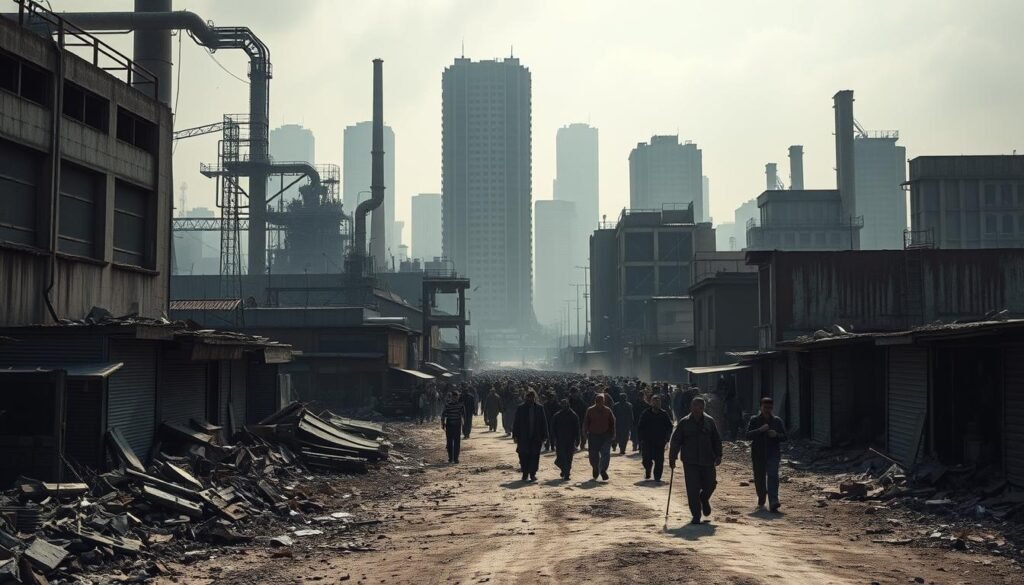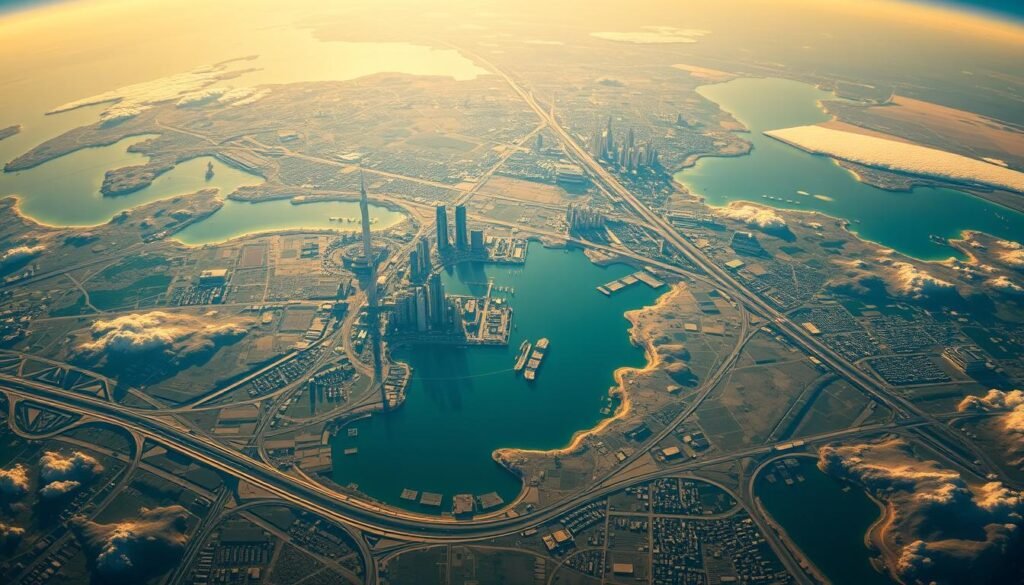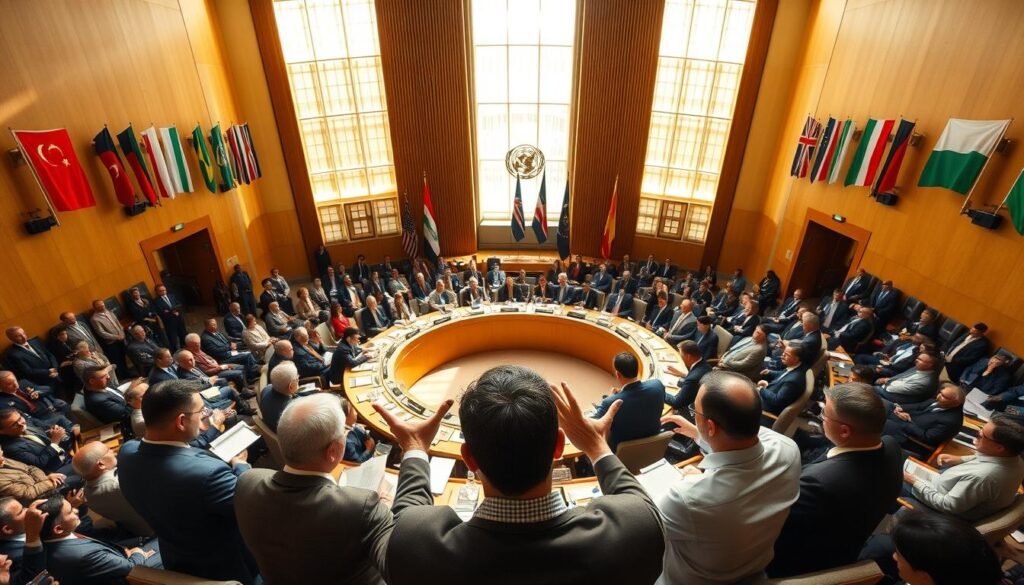The Future of Stability: Long-Term Consequences for the Middle East and Beyond.
Did you know nearly 60% of the Middle East’s population is under 30? This fact is key to understanding the region’s stability. Young people face high unemployment and economic struggles. These issues affect not just the Middle East but the world.
The Middle East has long faced instability. This is due to political turmoil, wars, and economic problems. Issues like poor governance, extremism, and internal conflicts add to the challenges. Without solutions, these problems could spread globally.
To ensure a stable future, we must tackle the Middle East’s complex challenges. We need international cooperation to find lasting solutions.
Key Takeaways
- Youth populations under 30 make up nearly 60% of the Middle East’s demographics.
- Political upheavals, wars, and socio-economic challenges have deep roots in the region.
- Governance issues and violent extremism significantly impact stability trends.
- Long-term disruptions in the Middle East affect global stability forecasts.
- Understanding and addressing these challenges is essential for sustainable stability.
The Current State of Political Instability in the Middle East
The Middle East is facing big political problems. Many things are causing trouble, like fights inside countries, bad government, corruption, violence, and threats from armies. We need to understand these issues to find ways to make peace and security last.
Internal Conflicts and External Threats
Countries like Syria and Iraq are fighting for a long time. These fights are because of different beliefs, ethnic groups, and political views. Also, threats from other countries and big powers make things worse. We must tackle these problems from all sides.
“Peace cannot be kept by force; it can only be achieved by understanding.” – Albert Einstein
Impact of Governance and Corruption
Bad government and corruption are big problems in the Middle East. When governments don’t work well, people get upset and protest. Corruption makes it hard to trust and follow the law. So, we need to fight corruption and make governments better.
Violent Extremism and Military Threats
Groups like ISIS have caused a lot of harm in the Middle East. They use violence and take advantage of weak governments. Wars between countries also make things worse. We need to fight these groups and help people change their ways.
| Factor | Impact on Stability | Possible Solutions |
|---|---|---|
| Internal Conflicts | Prolonged strife and tension | Negotiated settlements and reconciliation |
| External Threats | Increased regional instability | Diplomatic engagement and alliances |
| Poor Governance | Ineffective policymaking | Reforms and anti-corruption measures |
| Violent Extremism | Heightened security threats | Counter-terrorism and deradicalization |
| Military Conflicts | Displacement and destruction | Ceasefire agreements and peacebuilding |
Economic Pressures and Failures
In the Middle East, economic troubles are big due to oil dependence and high youth unemployment. This makes it hard for the economy to be stable. The region’s oil reliance makes it very sensitive to price changes, leading to instability.

High unemployment is another big problem. Young people in the Middle East struggle to find jobs, leading to economic frustration. The ongoing conflicts in the region make finding stable work even harder.
Trying to diversify economies has not worked well. Many countries in the Middle East have not moved beyond oil and gas. This limits jobs and hinders innovation and growth, which are key for stability.
Global economic downturns also hit the Middle East hard. A global economic slowdown can quickly affect the region, impacting everything from government budgets to private investments. This makes the quest for economic stability even more challenging.
Impact of Demographic Trends on Stability
In the Middle East, demographic trends are key to the region’s stability. Fast-growing populations and a large number of young workers create big challenges. It’s vital to tackle these issues to ensure lasting stability.
Youth Unemployment and Economic Marginalization
High youth unemployment is a major issue. Many young, educated people can’t find jobs. This leads to social unrest and might push some towards extremist views.
It’s important to match education with job needs and create jobs for the young. This can help prevent social problems.
Population Growth Challenges
Rapid population growth adds to the challenges. It puts a strain on infrastructure, healthcare, and education. Countries struggle to meet the needs of their growing populations.
There’s also a big demand for natural resources. To avoid running out, countries need to manage their populations well. This is key for long-term stability.
| Country | Youth Unemployment Rate (%) | Population Growth Rate (%) |
|---|---|---|
| Egypt | 32 | 2.0 |
| Jordan | 37 | 2.1 |
| Iraq | 25 | 2.7 |
Long-Term Development Impacts of Wars
The wars in Syria and Iraq have had a huge impact on their development. The ongoing conflicts have destroyed key infrastructure, displaced millions, and slowed economic growth. These effects are not just local but also affect the wider region’s stability and the need for effective reconstruction.
Case Study: Syria
In Syria, the war has destroyed hospitals, schools, and homes. A huge effort is needed to rebuild and restore normal life. The challenge is to bring back stability and rebuild the economy, which is currently in shambles.
Case Study: Iraq
Like Syria, Iraq’s development has been hit hard by war. The damage to infrastructure has made economic recovery tough. Iraq also needs a big effort to rebuild and ensure stability, which requires international help.
The stories of Syria and Iraq show the big problems wars cause for development and stability. It’s vital to work together to rebuild and ensure a stable future for the region.
Food Insecurity and Inflation
Food insecurity and inflation are big problems in the Middle East. They come from conflict, bad governance, and outside economic pressures. This creates a hard cycle to get out of.
The economic troubles make it tough to keep stability in the area. This is bad news for many communities.
Poor governance leads to bad distribution and corruption. This makes the crisis worse. People can’t afford basic things because prices keep going up.

The effects of these troubles aren’t just local. They affect the global market and international relations too. We need strong stability solutions to help now and in the future.
International aid and smart planning are key to solving these issues. They help create a stable place.
We must find real solutions to these problems. Fixing food insecurity and inflation is key for a better future in the Middle East. We need good governance and global help to beat these ongoing challenges.
The Role of Violent Extremism in Regional Instability
Violent extremism has become a major problem in many areas, like the Middle East. It disrupts social norms and challenges political and economic systems. It’s important to understand terrorism trends and how the world responds to them.
Terrorism Trends and Impacts
The rise of violent extremism has led to more terrorism. This has affected every part of society. Terror acts aim to spread fear and uncertainty, disrupting daily life and business.
They also erode trust in communities and between governments and people. This makes regional instability worse. Terror threats also hinder development and strain public resources, taking away from important services.
International Responses and Solutions
The world has been working hard to fight violent extremism. But, there are big challenges in finding effective solutions. The United Nations, NATO, and regional groups have played key roles in fighting terrorism.
But, it’s hard to coordinate efforts to stabilize regions. We need better intelligence sharing, specialized training, and programs to help communities. These are key to fighting terrorism effectively.
Unemployment and Its Long-Term Effects
Unemployment is a big problem in the Middle East, causing stability challenges and economic issues. It hits hard on the youth and women, making society unstable. This situation makes it hard for the region to grow and face existing problems.
Joblessness also links to radicalization. Young adults without jobs are more open to extremist views. This shows we need quick fixes to deal with unemployment’s long-term effects.

Policymakers must tackle unemployment’s roots. Improving education and job training can give young people needed skills. This helps reduce stability challenges and makes the economy more inclusive.
| Factors | Impact | Solutions |
|---|---|---|
| Youth Unemployment | Increased Risk of Radicalization | Enhanced Vocational Training |
| Women’s Unemployment | Economic Disparity | Gender-Sensitive Employment Policies |
| General Unemployment | Societal Instability | Comprehensive Economic Reforms |
Dealing with unemployment needs a wide range of solutions. By fixing both social and economic issues, we can build a better future for the Middle East and more.
The Future of Stability
Looking ahead, we see that the Middle East needs sustainable practices and new solutions to solve its problems. We must think about both quick fixes and long-term plans. These plans should help bring peace, grow the economy, and include everyone in politics.
Sustainable Stability Practices
Stable practices involve many steps. First, we need to diversify the economy to move away from oil. This means growing sectors like tech, tourism, and green energy. Next, we must improve how governments work by being open, fighting corruption, and having strong institutions.
It’s also important to make sure everyone has a say in their country’s future. This means giving a voice to young people, women, and those who are often left out. We can do this through changes in voting and by supporting community groups.
Innovative Stability Solutions
New solutions are needed to tackle the Middle East’s complex issues. Technology can help by making governments more transparent and improving services. For example, blockchain can track spending, and mobile tech can bring education and healthcare to hard-to-reach places.
Working with global groups, NGOs, and businesses can also bring fresh ideas. By using these enhancing stability strategies and innovative stability solutions, we can create a brighter future for the Middle East and the world.
Global Impact and Perceptions
The stability of the world is closely tied to the Middle East’s turmoil. This affects global security and economic interests. As countries’ actions become more connected, how we see stability is key to making global policies and helping others.

International Aid and Its Efficacy
Help from other countries is vital in trying to calm down unstable areas. But, how well this help works is often questioned. Aid that is well-planned can help right away and help build stability for the long run, which is good for the world.
But, aid that is not well thought out or is used for politics can make things worse. It’s important to be open and honest about how aid is given to make sure it helps.
Perceptions of Middle Eastern Stability from Global Perspectives
How we see stability around the world is influenced by many things. This includes what the media shows, how countries talk to each other, and their economic interests. The Middle East, with its complex politics and history of conflict, is a special case for the world.
Seeing the Middle East in a good light can help get more support and investment. But, if we see it badly, we might pull back and give less help. So, understanding the Middle East well is key to a stable world.
The Economic Consequences of Conflict
Conflict in the Middle East has big effects on both local and global markets. It leads to a big drop in foreign investments. This is because investors are scared off by the instability, causing a big decrease in money coming in.
This makes it hard for the economy to grow and develop. It creates a cycle that’s hard to get out of.
Trade routes are also disrupted. The Middle East is key for international trade, but conflicts keep interrupting it. These breaks hurt local economies and global supply chains too.
Businesses around the world face higher costs and delays. This makes the economic problems caused by instability even worse.
Long conflicts also use up a lot of a country’s resources. Governments spend a lot on the military, leaving little for important things like schools and hospitals. This makes it hard to recover and find stability.
To understand the economic effects, let’s look at some numbers from before and after conflicts in the Middle East:
| Country | GDP Growth Rate Before Conflict (%) | GDP Growth Rate After Conflict (%) | Foreign Direct Investment Before Conflict (USD Billion) | Foreign Direct Investment After Conflict (USD Billion) |
|---|---|---|---|---|
| Syria | 5.0 | -75.0 | 2.5 | 0.1 |
| Iraq | 7.7 | 1.7 | 4.8 | 1.2 |
| Yemen | 3.0 | -28.2 | 1.9 | 0.3 |
The table shows how conflicts hurt GDP growth and foreign investments. These numbers show how conflicts damage economies. They also show why we need to find ways to make economies more stable and resilient.
The Role of International Organizations
International organizations play a key role in tackling Middle Eastern instability. They offer financial help, developmental programs, and diplomatic solutions. We’ll look at how the United Nations, World Bank, and International Monetary Fund help build stability in the region.
The United Nations (UN)
The United Nations is vital in reducing conflicts and boosting stability. It runs peacekeeping missions and humanitarian aid programs. These efforts provide quick relief and set the stage for lasting stability.
The UN tackles the core issues of instability through conflict resolution and economic growth. This approach helps address the root causes of problems.
The World Bank and International Monetary Fund (IMF)
The World Bank and International Monetary Fund (IMF) are key players in stability efforts in the Middle East. They offer financial aid and policy guidance. This support is essential for economic reforms and infrastructure projects.
Their work is aimed at promoting sustainable economic growth and lowering risks. This helps build a more stable future.
| Organization | Role | Impact |
|---|---|---|
| United Nations (UN) | Peacekeeping, Humanitarian Aid | Conflict Resolution, Economic Development |
| World Bank | Financial Assistance, Economic Reforms | Infrastructure Development, Sustainable Growth |
| International Monetary Fund (IMF) | Policy Advice, Financial Support | Economic Stability, Reduced Vulnerabilities |
Regional Alliances and Their Influence
In our study of Middle Eastern stability, regional alliances play a huge role. They shape the political scene, guiding peace and conflict. These alliances impact stability through cooperation and competition.
The Gulf Cooperation Council (GCC) is a key stabilizer. It promotes economic and political unity among Gulf states. This shows how alliances can reduce tensions and boost growth.
On the other hand, alliances with different goals can make conflicts worse. Iran and Saudi Arabia’s involvement in regional fights shows how rival alliances can increase instability. Their strategic alliances deeply affect the region’s peace and security.
Groups like the Arab League are vital in solving conflicts. They show the good side of regional alliances in diplomacy. These groups help find solutions, leading to long-term stability.
“Regional alliances shape the pathways to either peace or conflict, depending on their underlying objectives and the coherence of their members.” — Analyst
Here’s a table comparing the effects of some regional alliances on Middle Eastern stability:
| Regional Alliance | Positive Influence | Negative Influence |
|---|---|---|
| Gulf Cooperation Council (GCC) | Economic cooperation, political unity | Intra-GCC disputes |
| Arab League | Conflict mediation, collective security | Ineffectiveness in resolving major conflicts |
| Iran-Syria-Hezbollah | Military support for allies | Exacerbation of proxy wars |
| Saudi Arabia-United States | Defense cooperation, economic investments | Perceived external intervention |
In summary, regional alliances are key in the Middle East’s politics. Whether they bring stability or more conflict depends on their goals and actions.
Geopolitical Tensions and Stability
Geopolitical tensions greatly affect both regional and global stability. In the Middle East, conflicts between countries like Israel and Iran have big effects. These tensions shape not just local areas but also the world’s stability forecast.
Tensions Between Israel and Iran
The rivalry between Israel and Iran is a major issue. Their differences lead to military battles and diplomatic problems. The fights over nuclear power and influence make peace hard to find.
Impact on Neighboring Countries
The fight between Israel and Iran affects nearby countries a lot. Places like Lebanon, Syria, and Iraq get caught in the middle. They face military battles, economic sanctions, and proxy wars.
Reconstruction Efforts and Challenges
Rebuilding the Middle East after conflicts is tough. Political divisions make it hard to work together. Also, not enough money is available, leaving projects unfinished.
Security problems also slow down the rebuilding. These issues make it hard to achieve lasting peace.
We need a plan that looks at both short-term needs and long-term goals. This plan should include economic growth, social inclusion, and political changes. Help from other countries is key to solving funding problems and sharing knowledge.
The aim is to create a stable and prosperous Middle East. This will lead to a better future for everyone.
Rebuilding efforts face many challenges. It’s important for local and international groups to work together. They must be ready to change their plans as needed to overcome obstacles.
Conclusion
Exploring long-term stability in the Middle East shows we need many strategies. We must tackle internal conflicts, economic issues, and population changes together. Our forecast shows fighting extremism and joblessness is key to lasting peace.
Many problems, like food shortages and rising prices, need teamwork from local and global groups. The United Nations and World Bank play big roles. They help find lasting solutions, not just quick fixes.
For lasting stability, we must work together on both urgent and deep issues. By rebuilding, strengthening bonds, and finding new ways to keep peace, the Middle East can thrive. This effort needs strong support from around the world to succeed.





